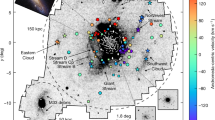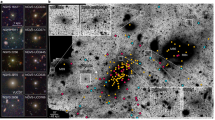Abstract
Globular clusters (GCs) are thought to be ancient relics from the early formative phase of galaxies, although their physical origin remains uncertain1,2. GCs are most numerous around massive elliptical galaxies, where they can exhibit a broad colour dispersion, suggesting a wide metallicity spread3. Here, we show that many thousands of compact and massive (~5 × 103–3 × 106 M⊙) star clusters have formed at an approximately steady rate over, at least, the past ~1 Gyr around NGC 1275, the central giant elliptical galaxy of the Perseus cluster. Beyond ~1 Gyr, these star clusters are indistinguishable in broadband optical colours from the more numerous GCs. Their number distribution exhibits a similar dependence with luminosity and mass as the GCs, whereas their spatial distribution resembles a filamentary network of multiphase gas4,5 associated with cooling of the intracluster gas6,7. The sustained formation of these star clusters demonstrates that progenitor GCs can form over cosmic history from cooled intracluster gas, thus contributing to both the large number and broad colour dispersion—owing to an age spread, in addition to a spread in metallicity—of GCs in massive elliptical galaxies. The progenitor GCs have minimal masses well below the maximal masses of Galactic open star clusters, affirming a common formation mechanism for star clusters over all mass scales8,9,10 irrespective of their formative pathways.
This is a preview of subscription content, access via your institution
Access options
Access Nature and 54 other Nature Portfolio journals
Get Nature+, our best-value online-access subscription
$29.99 / 30 days
cancel any time
Subscribe to this journal
Receive 12 digital issues and online access to articles
$119.00 per year
only $9.92 per issue
Buy this article
- Purchase on Springer Link
- Instant access to full article PDF
Prices may be subject to local taxes which are calculated during checkout



Similar content being viewed by others
Data availability
The data that support the plots within this paper and other findings of this study are available from the corresponding author on reasonable request.
References
Brodie, J. P. & Strader, J. Extragalactic globular clusters and galaxy formation. Annu. Rev. Astron. Astrophys. 44, 193–267 (2006).
Harris, W. E. Massive star clusters in galaxies. Philos. Trans. R. Soc. A 368, 889–906 (2010).
Harris, W. E. et al. Globular cluster systems in brightest cluster galaxies. III: beyond bimodality. Astrophys. J. 835, 101 (2017).
Salomé, P. et al. Cold molecular gas in the Perseus cluster core. association with X-ray cavity, Hα filaments and cooling flow. Astron. Astrophys. 454, 437–445 (2006).
Lim, J., Ohyama, Y., Chi-Hung, Y., Dinh-V-Trung & Shiang-Yu, W. A molecular hydrogen nebula in the central cD galaxy of the perseus cluster. Astrophys. J. 744, 112 (2012).
Cavagnolo, K. W., Donahue, M., Voit, G. M. & Sun, M. An entropy threshold for strong Hα and radio emission in the cores of galaxy clusters. Astrophys. J. 683, L107 (2008).
Werner, N. et al. The origin of cold gas in giant elliptical galaxies and its role in fuelling radio-mode AGN feedback. Mon. Not. R. Astron. Soc. 439, 2291–2306 (2014).
Kroupa, P. & Boily, C. M. On the mass function of star clusters. Mon. Not. R. Astron. Soc. 336, 1188–1194 (2002).
Whitmore, B. C. et al. The antennae galaxies (NGC 4038/4039) revisited: advanced camera for surveys and NICMOS observations of a prototypical merger. Astron. J. 140, 75–109 (2010).
Howard, C. S., Pudritz, R. E. & Harris, W. E. A universal route for the formation of massive star clusters in giant molecular clouds. Nat. Astron. 2, 725–730 (2018).
Holtzman, J. A. et al. Planetary camera observations of NGC 1275: discovery of a central population of compact massive blue star clusters. Astron. J. 103, 691 (1992).
Carlson, M. N. et al. Deep Hubble Space Telescope observations of star clusters in NGC 1275. Astron. J. 115, 1778–1790 (1998).
Richer, H. B., Crabtree, D. R., Fabian, A. C. & Lin, D. N. C. Star and cluster formation in NGC 1275. Astron. J. 105, 877 (1993).
Canning, R. E. A. et al. Star formation in the outer filaments of NGC 1275. Mon. Not. R. Astron. Soc. 405, 115–128 (2010).
Canning, R. E. A. et al. Filamentary star formation in NGC 1275. Mon. Not. R. Astron. Soc. 444, 336–349 (2014).
Werner, N., Urban, O., Simionescu, A. & Allen, S. W. A uniform metal distribution in the intergalactic medium of the Perseus cluster of galaxies. Nature 502, 656–658 (2013).
Yu, A. P. Y., Lim, J., Ohyama, Y., Chan, J. C. C. & Broadhurst, T. The high-velocity system: infall of a giant low-surface-brightness galaxy toward the center of the Perseus cluster. Astrophys. J. 814, 101 (2015).
Harris, W. E. et al. Globular cluster systems in brightest cluster galaxies: a near-universal luminosity function? Astrophys. J. 797, 128 (2014).
Carlson, M. N. & Holtzman, J. A. Measuring sizes of marginally resolved young globular clusters with the Hubble space telescope. Publ. Astron. Soc. Pac. 113, 1522–1540 (2001).
Brockamp, M., Küpper, A. H. W., Thies, I., Baumgardt, H. & Kroupa, P. Erosion of globular cluster systems: the influence of radial anisotropy, central black holes and dynamical friction. Mon. Not. R. Astron. Soc. 441, 150–171 (2014).
Whitmore, B. C., Schweizer, F., Leitherer, C., Borne, K. & Robert, C. Hubble space telescope discovery of candidate young globular clusters in the merger remnant NGC 7252. Astron. J. 106, 1354–1370 (1993).
Whitmore, B. C. & Schweizer, F. Hubble space telescope observations of young star clusters in NGC 4038/4039, ‘The Antennae’ galaxies. Astron. J. 109, 960–980 (1995).
O’Connell, R. W., Gallagher, I., John, S., Hunter, D. A. & Colley, W. N. Hubble space telescope imaging of super star clusters in M82. Astrophys. J. 446, L1 (1995).
Schweizer, F., Miller, B. W., Whitmore, B. C. & Fall, S. M. Hubble space telescope observations of candidate young globular clusters and stellar associations in the recent merger remnant NGC 3921. Astron. J. 112, 1839–1862 (1996).
Lim, S., Hwang, N. & Lee, M. G. The star cluster system in the nearby starburst galaxy M82. Astrophys. J. 766, 20 (2013).
Lada, C. J. & Lada, E. A. Embedded clusters in molecular clouds. Annu. Rev. Astron. Astrophys. 41, 57–115 (2003).
Bik, A., Lamers, H. J. G. L. M., Bastian, N., Panagia, N. & Romaniello, M. Clusters in the inner spiral arms of M 51: the cluster IMF and the formation history. Astron. Astrophys. 397, 473–486 (2003).
Barmby, P., Kuntz, K. D., Huchra, J. P. & Brodie, J. P. Hubble space telescope observations of star clusters in M101. Astron. J. 132, 883–890 (2006).
Lucas, R. A. et al. ACS Data Handbook Version 9.0 (Space Telescope Science Institute, 2018); https://go.nature.com/2nMDjVQ
Diolaiti, E. et al. Analysis of isoplanatic high resolution stellar fields by the StarFinder code. Astron. Astrophys. Suppl. Ser. 147, 335–346 (2000).
Cardelli, J. A., Clayton, G. C. & Mathis, J. S. The relationship between infrared, optical, and ultraviolet extinction. Astrophys. J. 345, 245–256 (1989).
Zackrisson, E., Rydberg, C.-E., Schaerer, D., Ostlin, G. & Tuli, M. The spectral evolution of the first galaxies. I. James webb space telescope detection limits and color criteria for population III galaxies. Astrophys. J. 740, 13 (2011).
Leitherer, C. et al. Starburst99: synthesis models for galaxies with active star formation. Astrophys. J. Suppl. Ser. 123, 3–40 (1999).
Kroupa, P. On the variation of the initial mass function. Mon. Not. R. Astron. Soc. 322, 231–246 (2001).
Acknowledgements
This work was based on observations made with the NASA/ESA Hubble Space Telescope, and obtained from the Hubble Legacy Archive, which is a collaboration between the Space Telescope Science Institute (STScI/NASA), the Space Telescope European Coordinating Facility (ST-ECF/ESA) and the Canadian Astronomy Data Centre (CADC/NRC/CSA). J.L. acknowledges support from the Research Grants Council of Hong Kong through grants 17303414 and 17304817. Y.O. acknowledges support by grant MOST 107-2119-M-001-026-. T.B. thanks University of Hong Kong for generous support from the Visiting Research Professor Scheme.
Author information
Authors and Affiliations
Contributions
J.L. supervised the project and wrote the paper. E.W. and Y.O. conducted the technical aspects of the work. T.B. and E.M. initiated the project and participated in the interpretation of the results.
Corresponding author
Ethics declarations
Competing interests
The authors declare no competing interests.
Additional information
Peer review information Nature Astronomy thanks Pavel Kroupa and the other, anonymous, reviewer(s) for their contribution to the peer review of this work.
Publisher’s note Springer Nature remains neutral with regard to jurisdictional claims in published maps and institutional affiliations.
Supplementary information
Supplementary Information
Supplementary Figs. 1–11, Tables 1–4 and refs. 1–14
Rights and permissions
About this article
Cite this article
Lim, J., Wong, E., Ohyama, Y. et al. Sustained formation of progenitor globular clusters in a giant elliptical galaxy. Nat Astron 4, 153–158 (2020). https://doi.org/10.1038/s41550-019-0909-6
Received:
Accepted:
Published:
Issue Date:
DOI: https://doi.org/10.1038/s41550-019-0909-6



